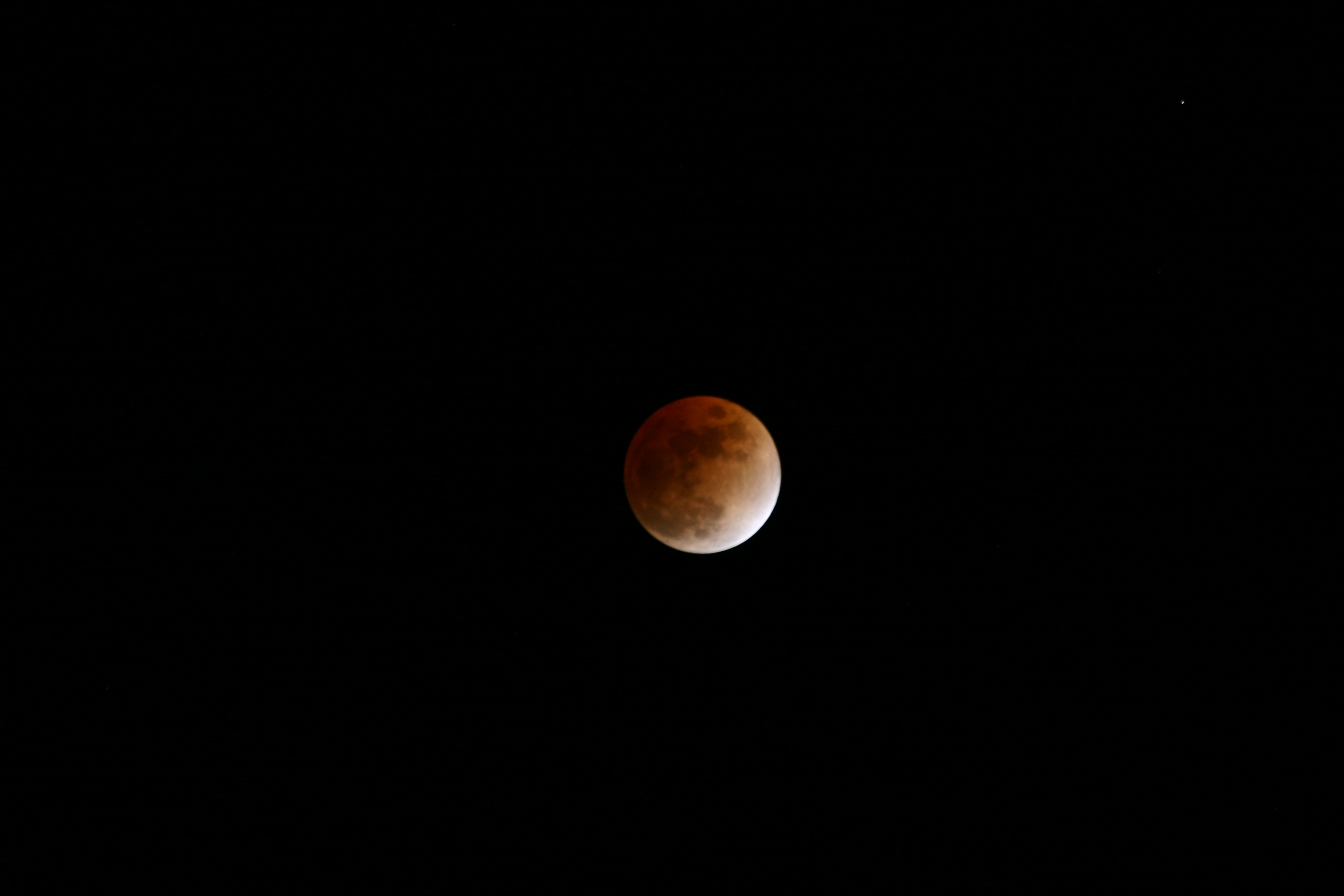
|
| Total lunar eclipse photographed on February 21, 2008. Digital image shot at f/5.6 using a 200mm telephoto lens for 2 seconds at ISO 200. (Photo by Curt Roelle) |
Mark your calendar for December's upcoming total lunar eclipse on Tuesday the 21st. It will be the first total lunar eclipse visible in our region since one nearly three years ago, in February 2008. The eclipse can be viewed all across North America wherever skies are clear.
What causes a total lunar eclipse?
The moon travels in orbit once around the earth on a roughly monthly basis. "Every so often it passes through the earth's own shadow. From earth we view the shadow, curved by the shape of our own planet, as it slowly sweeps across the moon.
What does an eclipse look like?
Because of the sun-earth-moon geometry, a lunar eclipse only happens at full moon. The moon rises while the sun sets and then sets as the sun rises. The earth is situated between the sun and the full moon.
The earth's shadow has two components referred to as the penumbra and umbra. The penumbra is faint, subtle, and difficult to view. The umbra is darker and much easier to see.
Prior to the eclipse, the moon appears full and everything is normal. However, once the umbra reaches the moon's limb, or edge, the effect is highly irregular. The "partial" phase of the eclipse has begun. A curved dark notch appears at the edge and begins spreading across the lunar disc.
The shadow itself can appear brown or ruddy. The color is caused by sunlight refracted by the earth's atmosphere and scattered across the moon. It's been said that this is the light from all of the earth's simultaneous sunrises and sunsets occurring at the moment.
"Totality" begins once the shadow has entirely engulfed the moon. The color and darkness of the moon varies from one eclipse to the next. During the upcoming eclipse, totality lasts about 74 minutes. If you're lucky enough to be away from city lights, you may notice, in the fading brilliance of the eclipsing moon, hundreds of previously washed out stars have becoming visible in the night sky.
The trailing edge of the shadow brings totality to an end. As the earth's umbral shadow retreats, the moon brightens and the stars start fading. This is the second partial phase of the eclipse. Once the shadow leaves the moon, the eclipse ends and the full moon returns once again.
This month's eclipse occurs in the early hours of Tuesday morning. According to Guy Ottewell's Astronomical Calendar for 2010, the partial eclipse starts at 1:32 a.m. EST. This is known as "1st contact." Total lunar eclipse, or "2nd contact," begins at 2:40 a.m. Mid-eclipse occurs at 3:17 a.m. Totality ends at "3rd contact," at 3:54 a.m. Partial eclipse stops at 5:02 a.m., at "4th contact."
How to view the eclipse?
No special equipment other than your two eyes are required. A telescope will enhance the close-up view — especially if totality is unusually dim — as the shadow creeps across various craters and mountain ranges. I recall that a previous December eclipse, in 1982, was very dark. Although I could still see it through a telescope, the moon was practically invisible to the unaided eye.
I was listening to the radio then as an announcer mentioned how, at that precise time, a fully eclipsed moon was visible outside. I laughed to myself, imagining people going outdoors, looking up, and seeing nothing at all. A more informative announcer might have mentioned it sooner, during the partial eclipse, when at least a sliver of moonlight was still visible. Then his listeners could have followed the spectacle as the moon dramatically faded to darkness.
The moon was dark that year because volcanic aerosols in the earth's atmosphere, from an eruption in Mexico, dramatically reduced the amount of refracted light being scattered by the atmosphere. This year, the moon is expected to remain brighter.
Binoculars are perfect for viewing the eclipse. Warm clothes are an essential accessory. Winter clothing, a hat, gloves, and a coat are recommended. I prefer not to remain standing during the eclipse. I plan to use a lawn chair with either a sleeping bag or warm blankets on top and beneath. Raising the chair to the proper angle allows an observer to comfortably view the eclipse. Get out your binoculars, if you have a pair.
The moon will ride fairly high in our sky that night. When the partial eclipse begins, it will be 65º up, or 2/3 of the way between the horizon and the zenith straight overhead.
A tripod-mounted camera may be used for photographing the eclipse. Use short exposures during the partial phases. Try various exposures between 1/200 second and ISO 200 to 1 second and ISO 800. Exposures longer than one second work well during totality. Use the camera's timer or a cable release to reduce vibration. Digital cameras are useful because you can see your results instantly and adjust your settings as needed. The best way is by experimenting with different settings to find the best results for your camera.
I would be pleased to hear about your eclipse-watching experience.

|
| Total lunar eclipse photographed on February 21, 2008. Digital image shot at f/5.6 using a 200mm telephoto lens for 2 seconds at ISO 200. (Photo by Curt Roelle) |